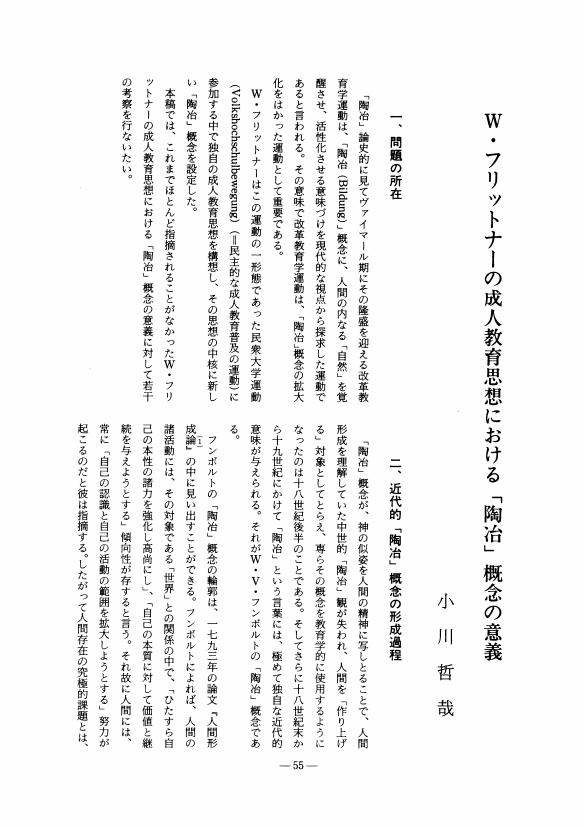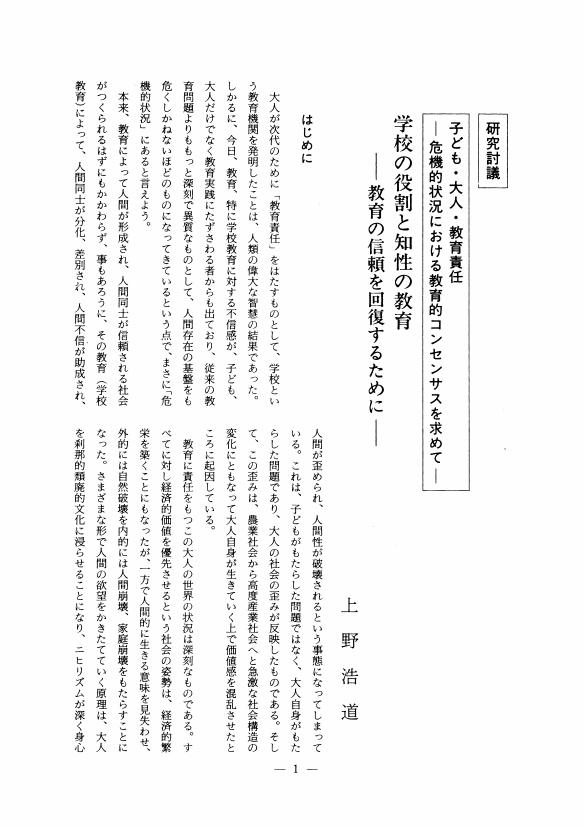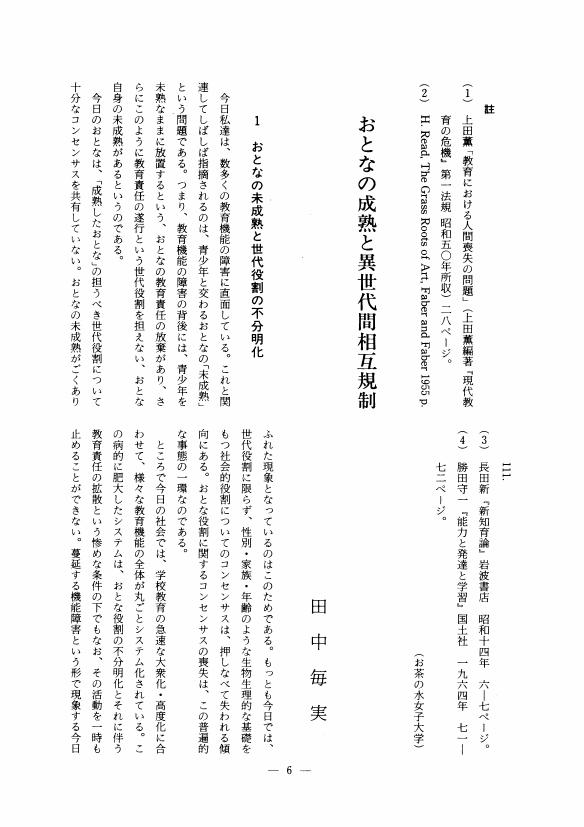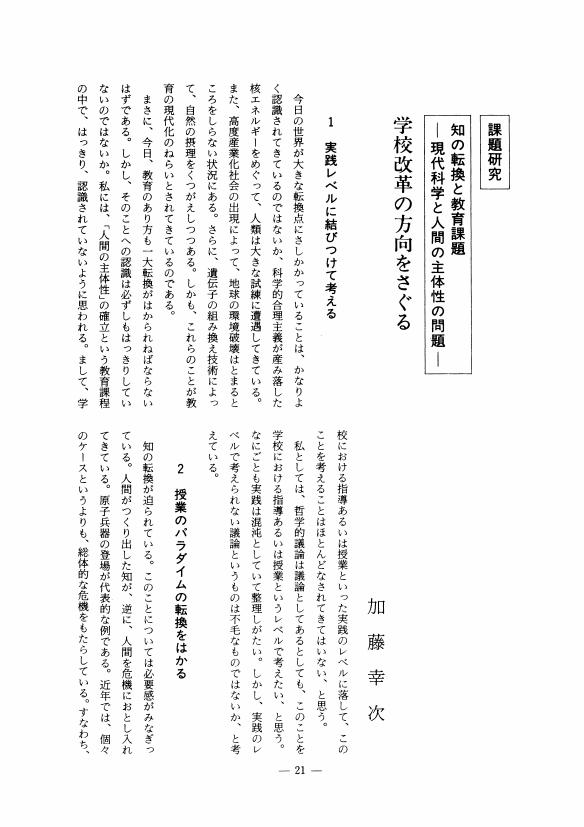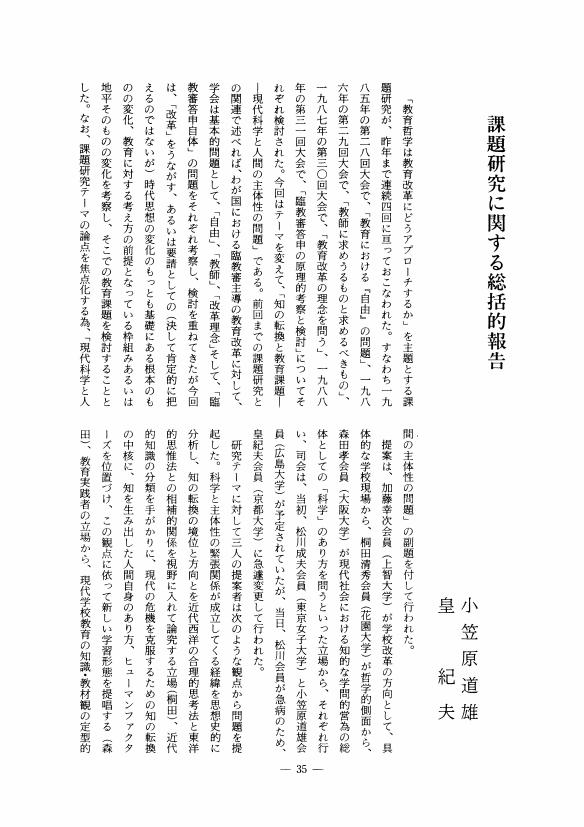1 0 0 0 OA 能勢榮譯註『莱因氏教育學』底本攷
- 著者
- 岡本 英明
- 出版者
- 教育哲学会
- 雑誌
- 教育哲学研究 (ISSN:03873153)
- 巻号頁・発行日
- vol.1990, no.61, pp.79-82, 1990-05-10 (Released:2009-09-04)
- 参考文献数
- 7
1 0 0 0 OA ヘルバルト教育学における趣昧判断の位置づけ
- 著者
- 浜田 栄夫
- 出版者
- 教育哲学会
- 雑誌
- 教育哲学研究 (ISSN:03873153)
- 巻号頁・発行日
- vol.1990, no.62, pp.16-31, 1990-11-10 (Released:2010-01-22)
- 参考文献数
- 49
It is very important to consider Herbart's educational thought in connection with aesthetic judgement. The notion of taste is not only one of the central ideas in Herbart's pedagogy, but also an important notion in pedagogy as a whole.In the course of the development from “The Aesthetic Presentation of the Universe as the Chief Office of Education” (1802) to “General Principles of the Science of Education Deduced from its Aim” (1806), it looks as if the viewpoint of education for taste were receding or as if it were included into the problems of thought circle. However, Herbart keeps the viewpoint of education for taste throughout. Therefore we are permitted to consider the teaching and the training aim expounded in “General Principles of the Science of Education” in terms of his ideas on aesthetic judgement.We may say, by way of conclusion, that education for taste is a consistent and original viewpoint in Herbart's pedagogy and that it constitutes a realistic attempt to promote the integration of our inner life.We may interpret this attempt under the following aspects : 1. The premise of aesthetic judgement ;2. The aim of instruction and aesthetic judgement ;3 The 'solid moral character' and aesthetic judgement.
1 0 0 0 OA ロジャーズに対するブーバーの異議 援助的関係における「対等性」と「受容」の問題をめぐって
- 著者
- 吉田 敦彦
- 出版者
- 教育哲学会
- 雑誌
- 教育哲学研究 (ISSN:03873153)
- 巻号頁・発行日
- vol.1990, no.62, pp.32-46, 1990-11-10 (Released:2009-09-04)
- 参考文献数
- 28
This paper deals with the problem of the 'helping relationship' and tries to clarify the real position of Buber when in the dialogue between him and Rogers, he raises objections against the latter. The aim of our discussion is to bring into focus the peculiar nature of Buber's thought who takes a third stand between two positions-on the one side Buber's opposition to the indoctrinating type of the Zwangsschule-which he shares with Rogers, and on the other hand Buber's opposition to the Freie Schule leaving room for growth.First, we consider Buber's argument that there is a limit to the proposal of Rogers who insists that a relation of equality exists between the giver and receiver of assistance (help).Secondly we examine, rising up to Buber's human ontology, the problem of the attitude required of the assisting person through Roger's concept of 'acceptance' in contrast to Buber's concept of 'confirmation' (Bestätigung) of 'potentiality'. We discover there in the relation to the assisted person the confirmation of a power directed toward the realization of truth (Wahrheit) as the basic attitude of the assisting person.
1 0 0 0 OA 教育哲学を考える
- 著者
- 小林 政吉
- 出版者
- 教育哲学会
- 雑誌
- 教育哲学研究 (ISSN:03873153)
- 巻号頁・発行日
- vol.1990, no.62, pp.47-48, 1990-11-10 (Released:2009-09-04)
1 0 0 0 OA ボルノーの「助言」 (Beratung) の概念 教育における存在と価値の問題に関連して
- 著者
- 関川 悦雄
- 出版者
- 教育哲学会
- 雑誌
- 教育哲学研究 (ISSN:03873153)
- 巻号頁・発行日
- vol.1990, no.62, pp.49-54, 1990-11-10 (Released:2009-09-04)
- 参考文献数
- 7
1 0 0 0 OA W・フリットナーの成人教育思想における「陶冶」概念の意義
- 著者
- 小川 哲哉
- 出版者
- 教育哲学会
- 雑誌
- 教育哲学研究 (ISSN:03873153)
- 巻号頁・発行日
- vol.1990, no.62, pp.55-60, 1990-11-10 (Released:2009-09-04)
- 参考文献数
- 6
- 著者
- 上野 浩道
- 出版者
- 教育哲学会
- 雑誌
- 教育哲学研究 (ISSN:03873153)
- 巻号頁・発行日
- vol.1990, no.61, pp.1-6, 1990-05-10 (Released:2009-09-04)
- 参考文献数
- 4
1 0 0 0 OA おとなの成熟と異世代間相互規制
- 著者
- 田中 毎実
- 出版者
- 教育哲学会
- 雑誌
- 教育哲学研究 (ISSN:03873153)
- 巻号頁・発行日
- vol.1990, no.61, pp.6-11, 1990-05-10 (Released:2009-09-04)
1 0 0 0 OA フイルター・自己活動・回想 モレンハウア-『忘れられた連関』の余白に
- 著者
- 今井 康雄
- 出版者
- 教育哲学会
- 雑誌
- 教育哲学研究 (ISSN:03873153)
- 巻号頁・発行日
- vol.1990, no.61, pp.11-16, 1990-05-10 (Released:2009-09-04)
- 参考文献数
- 5
1 0 0 0 OA 討論経過のまとめ
- 著者
- 堀内 守
- 出版者
- 教育哲学会
- 雑誌
- 教育哲学研究 (ISSN:03873153)
- 巻号頁・発行日
- vol.1990, no.61, pp.17-20, 1990-05-10 (Released:2009-09-04)
1 0 0 0 OA 知の転換と教育課題-現代科学と人間の主体性の問題- 学校改革の方向をさぐる
- 著者
- 加藤 幸次
- 出版者
- 教育哲学会
- 雑誌
- 教育哲学研究 (ISSN:03873153)
- 巻号頁・発行日
- vol.1990, no.61, pp.21-24, 1990-05-10 (Released:2009-09-04)
1 0 0 0 OA 現代科学と人間の主体性 問題の予備的考察
- 著者
- 桐田 清秀
- 出版者
- 教育哲学会
- 雑誌
- 教育哲学研究 (ISSN:03873153)
- 巻号頁・発行日
- vol.1990, no.61, pp.24-30, 1990-05-10 (Released:2009-09-04)
1 0 0 0 OA 知の転換と教育課題
- 著者
- 森田 孝
- 出版者
- 教育哲学会
- 雑誌
- 教育哲学研究 (ISSN:03873153)
- 巻号頁・発行日
- vol.1990, no.61, pp.30-34, 1990-05-10 (Released:2009-09-04)
1 0 0 0 OA 課題研究に関する総括的報告
- 著者
- 小笠原 道雄 皇 紀夫
- 出版者
- 教育哲学会
- 雑誌
- 教育哲学研究 (ISSN:03873153)
- 巻号頁・発行日
- vol.1990, no.61, pp.35-36, 1990-05-10 (Released:2009-09-04)
1 0 0 0 OA 「超越論的批判教育学」の意味するものとその射程
- 著者
- 土戸 敏彦
- 出版者
- 教育哲学会
- 雑誌
- 教育哲学研究 (ISSN:03873153)
- 巻号頁・発行日
- vol.1990, no.61, pp.37-49, 1990-05-10 (Released:2009-09-04)
- 参考文献数
- 52
Transzendentalkritische Pädagogik ist eine unter Positionen wissenschaftlicher Pädagogik in der Bundesrepublik Deutschland. Sie folgt dem Neukantianismus und versucht zugleich seine Problematische Seite kritisch zu aberwinden. Sie fragt nicht danach, wie der Erzieher verfahren soll, sondern danach, was Bildung ist. Eine der Aufgaben transzendentalkritischer Pädagogik besteht also darin, eine die Erziehungs-wirklichkeit und padagogische Theorien beherrschende Selbstverstandlichkeit zu aber-winden und die diesen zugrunde liegenden dogmatisch-metaphysischen Voraussetzungen ans Licht zu bringen. Das Moment der moralischen Autonomie einerseits und das der Erkenntniskritik andererseits in Kants Philosophie fahren aber theoretische Differenzen in diese Pädagogik ein. Da ist einmal die Ansicht, daß es eine padagogische Letztnorm-die Norm der Verbindlichkeit oder Geltung-gibt, zum anderen gibt es die Auffassung, daß das Normproblem ein falsch gestelltes Problem ist, und die padagogische Aufgabe vielmehr auf das Legimitationsproblem verweist. Somit ist die Beziehung der beiden Auffassungen zur padagogischen Wirklichkeit ganz verschieden. Wie dem auch sein mag, der Kernpunkt der transzendentalkritischen Pädagogik liegt darin, daß die tran-szendentale Kritik nicht nur eine wissenschaftlich-pädagogische Aufgabe, sondern als Philosophieren eine Aufgabe jedes einzelnen lebendigen Menschen darstellt.
1 0 0 0 OA 子供における「死」の理解について 子供が「生きる」ことを知ってゆくこととの関連で
- 著者
- 鈴木 志乃恵
- 出版者
- 教育哲学会
- 雑誌
- 教育哲学研究 (ISSN:03873153)
- 巻号頁・発行日
- vol.1989, no.60, pp.68-71, 1989-11-10 (Released:2009-09-04)
1 0 0 0 OA 身体的思考についての研究
- 著者
- 滝沢 文雄
- 出版者
- 教育哲学会
- 雑誌
- 教育哲学研究 (ISSN:03873153)
- 巻号頁・発行日
- vol.1989, no.60, pp.72-76, 1989-11-10 (Released:2009-09-04)
- 参考文献数
- 2
1 0 0 0 OA N・チョムスキーの「生得的言語能力」論と「意味解釈規則論」 その教育思想的な帰結の意味
- 著者
- 小川 智史
- 出版者
- 教育哲学会
- 雑誌
- 教育哲学研究 (ISSN:03873153)
- 巻号頁・発行日
- vol.1989, no.60, pp.77-81, 1989-11-10 (Released:2009-09-04)
1 0 0 0 OA ゲーテ『ヴィルヘルム・マイスター』における人間形成について
- 著者
- 山本 かおり
- 出版者
- 教育哲学会
- 雑誌
- 教育哲学研究 (ISSN:03873153)
- 巻号頁・発行日
- vol.1989, no.60, pp.82-85, 1989-11-10 (Released:2009-09-04)
- 参考文献数
- 6
1 0 0 0 OA ボン大学留学体験から
- 著者
- 米山 弘
- 出版者
- 教育哲学会
- 雑誌
- 教育哲学研究 (ISSN:03873153)
- 巻号頁・発行日
- vol.1989, no.60, pp.86-91, 1989-11-10 (Released:2009-09-04)



